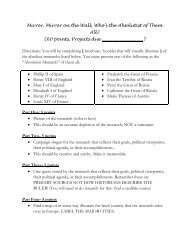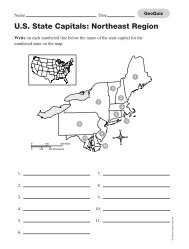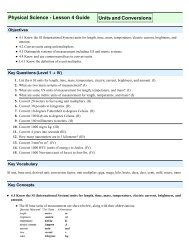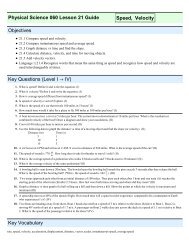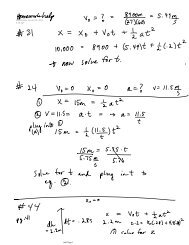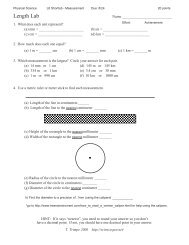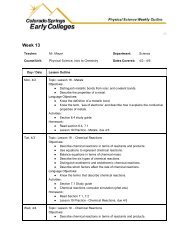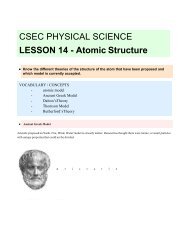arc considered optional. They can be o
arc considered optional. They can be o
arc considered optional. They can be o
- No tags were found...
You also want an ePaper? Increase the reach of your titles
YUMPU automatically turns print PDFs into web optimized ePapers that Google loves.
Srarong /h~ uIKmimyAssumed ""ur/(JilllyWhen giving the result of il meilsu r ~menl, it is im port'lnl to st,'le Ihe u ti.mated uncertainty in the mea>uremenL For e~il mplc, the widlh of;l bo;lrd mighl<strong>be</strong> written ;IS 8.8 ± O. t em. The ± 0,1 em ("plus or minus 0.1 em") repro.urement, so thilt the ildu;ll widlh most likelylies <strong>be</strong>lween 8.7 and 8.9em, The percent uncertainly is simply the r;Jrio of theunecrtilinty to the measured v;Jlue, multiplied by tOO. For e~ilmple, if the me,lSurementis 8.8 ,lnd the unccrtairl\y aboul 0.1 cm, the pe re~rl\ uncert;Jinty is0.1- X 100% "" 1%8.'where '" means ~is roughly equal to."Of len the uncertainty in a measured val ue is nOI spi'cificd explicitly. In suchcases, Ihe uncertainty is generally assumed to <strong>be</strong> one or a few unils in Ihe laSIdigit specified. For example. if a length is given as 8.8cm. the uncertainty isassumed 10 <strong>be</strong> about 0.1 em or O.2cm.lt is importanl in this case that you do nOIwrile 8.SOem, for this implies an uncertainly on Ihe order of 0.01 em; il assumesIhal the lenglh is probably <strong>be</strong>tween 8.7gem and 8.81 em. when actually yo u<strong>be</strong>lieve it is <strong>be</strong>tween 8.7 and 8.9cm.CONCEPTUAL EXAMPLE 1-1 Is the diamond yours? A friend asks toborrow your precious diamond for a day to show her family. You Jre a bilworried. so you carefully have your diamond weighed on a s.cale which reads8.17 grams. The scale's accu racy is claimed to <strong>be</strong> ± 0.05 gram. The next day youweigh the relurned diamond again, getting 8.09 grams. Is this your diamond?RESPONSE The s.cale readings <strong>arc</strong> measuremenlS and do not necessarily givethe "true" value of Ihe mass. Each meJSuremenl could have <strong>be</strong>en high or lowby up 10 0.05 gram or so. The actual mass of you r diamond lies most likely<strong>be</strong>tween 8.12 grams Jnd 8.22 grams. The aClual mass of Ihe returned diamondis most likely <strong>be</strong>tween 8.04 grams and 8.14 grams. These IWO ranges overlap, sothere is nOI a strong reason to doubt that Ihe returned diamond is yours, atleast based on the s.cJIe reJdings._ PROBLEM SOLVING.'>'lIm<strong>be</strong>r of signifieo," figllres in fi/Ullres,,11 should <strong>be</strong> SlIme os leas/signifi<strong>can</strong>t inpou ,,,,/,,e6 CHAPTER 1Signifi<strong>can</strong>t FiguresThe num<strong>be</strong>r of reliably known digi\.s in a num<strong>be</strong>r is cillled the num<strong>be</strong>r of~ ignifi ca nt figurl"S. Thus there ilr~ four signifiCilnl figures in the num<strong>be</strong>r 23.21 cmilnd two in the lIum!J.t, r 0.062 cm (the 'l.eros in the Iilller ,lie merely plilee holdersthill show whe re the decimill point goes), The num<strong>be</strong>r of signifiC;lnt figures m;Jynot alw;Jys <strong>be</strong> ck;lr. Take, for e' ilm ple, the lIum<strong>be</strong>r SO. Arc Ihere one or twosignifi<strong>can</strong>l figures? If we say it is ilIJ01I1 80km <strong>be</strong>tweell two cities, Ihere is onlyone signifi<strong>can</strong>t figure (the 8) since Ihe ze ro is merely a place holder. If it isHilelly 80 km within an accuracy of 1 or 2 km, then the SO has IWO signifi<strong>can</strong>lfigures. ' If il is precisely RO km, to within ± 0.1 km, Ihen we write RO.O km.When making mea\urement~ or when doing calculations, you should avoidthe lemptation 10 kee p more digits in Ihe final answer than is juslified. Forexample, to calculate the area of a rectangle 11.3cm hy 6.8cm, the result ofmultiplication would he 76.84cml. But this answer is clearly not accurale 100.01 cm 1 , since (using the outer limits of Ihe as.~umed uncertainty for eachmeasurement) the result could <strong>be</strong> <strong>be</strong>tween 11.2 em x 6.7 em = 75.04 cm 1 andII.4cm x 6.9cm = 78.66cm 1 . At <strong>be</strong>st. \\"e <strong>can</strong> quote the answer as 77C111 1 ,which im plies an uncertainly of about 1 or 2cm 1 . The olher IWO digits (i n thenum<strong>be</strong>r 76.84cm 1 ) must <strong>be</strong> dropped sillce they <strong>arc</strong> not signifi<strong>can</strong>t. As a roughgeneral rule (i.e., in the absence of a detailed cOllsideration of uncertainties), we<strong>can</strong> say that Ihe final resufl of a ",ulliplictlliOIl or divisioll sllOfiM have only asmally digilS as Ihe num<strong>be</strong>r ,villl lire leasl num<strong>be</strong>r of signifi<strong>can</strong>t figures used ill lirecalmlillioll. [n our example, 6.8cm has the least num<strong>be</strong>r of signifi<strong>can</strong>t figures.namely t\\"o. Thus Ihe resolt 76.84 cm 1 needs to <strong>be</strong> ro unded off to 77 cm 1 .' If tho 80 has Iv.'(> ,ignofo<strong>can</strong>t figu,o,"."mc pcw tc r refor 10 ""ito il 8!J. v.'ilh • docomal roin l. Thi, i,not u,u.lly done. '" 'he num!>



